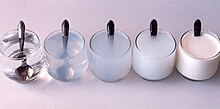





Cesia is the name given to visual appearances related to the perception of different spatial distributions of light. Light radiation that is not absorbed by an object can be reflected or transmitted either diffusely or regularly. These interactions of light with matter are perceived with a greater or lesser degree of gloss (from a mirror to a matte surface, as the extremes), more or less transparent, translucent or opaque, at different levels of darkness (according to the light-dark axis).
Background and development of the concept
This is the same kind of phenomenon that Richard S. Hunter (1969) calls "geometric attributes of appearance". The advantage is that the concept of cesia encompasses all the involved aspects in a single word, and that all cesias have been organized in a three-dimensional order system according to three axes of variation, similar to color order systems or color models.
Before Richard Hunter, who also developed instruments for the measurement of these aspects of appearance, some other forerunners on these aspects include the German psychologist David Katz, the Optical Society of America (OSA), and the philosopher Ludwig Wittgenstein. Katz was the first to understand that there are different modes of color appearance, such as surface colors (opaque), film colors (related to transparency), volume colors (related to transparency but also to translucency), mirrored colors and luster. The Committee on Colorimetry of the OSA proposed eleven attributes to classify different aspects of visual appearance, of which the last three attributes are transparency, glossiness and luster. Among other issues, Wittgenstein discusses about the impossibility for something being called "transparent white", the relationship between "golden" and "yellow" (with and without gloss), which is similar to the relationship between "silver" and "gray", or the possibility of speaking about "black mirrors".
The axes of variation of cesia are: permeability to light (with transparent and opaque as the extremes), diffusivity (with diffuse and regular -or sharp- as the extremes), and darkness (with the poles light and dark -or black). The variable of diffusivity, which involves different degrees of light scattering, from zero to maximum, and the appearances in-between the two extremes, is related to the concept of distinctness of image (DOI).
The term "cesia" was proposed by César Jannello in the 1980s. Jannello died in 1985 without developing the concept in depth (beyond the fact that it refers to qualities or visual appearances such as transparency, translucency, gloss, opacity, etc.), and without devising an order system of cesias. This was the purpose of José Luis Caivano since the late eighties and early nineties. Subsequently, the concept of cesia was also taken up and expanded by other authors, who applied it to different fields: Green-Armytage (1993, 2017), Lozano (2006), Giglio (2015), Jofré (2017), to mention just a few.

See also
- Distinctness of image
- Frosted glass
- Gloss (optics)
- Luster (textiles)
- Lustre prints
- Opacity (optics)
- Paint sheen
- Reflection (physics)
- Scattering theory
- Transparency and translucency
References
- Hunter, Richard S. 1969. “Geometric and color attributes of object appearance”. In: AIC Color 69, Proceedings of the First Congress of the International Color Association, Stockholm, 9–13 June 1969, ed. M. Richter (Göttingen: Muster-Schmidt, 1970), vol. 1: 525–529.
- Hunter, Richard S. 1975. The measurement of appearance (New York: John Wiley & Sons).
- Katz, David. 1911. Die Erscheinungsweisen der Farben Und ihre Beeinflussung durch die individuelle Erfahrung (Leipzig: Johann Ambrosius Barth). 2nd ed., Der Aufbau der Farbwelt (1930). English translation by R. B. MacLeod and C. W. Fox, The world of colour (London: Keagan Paul, Trench, Trubner, 1935).
- Optical Society of America, Committee on Colorimetry. 1953. The science of color (New York: Crowell), Chapter 2.
- Wittgenstein, Ludwig. 1950–1951. Bemerkungen über die Farben. English translation by L. McAlister and M. Schättle, Remarks on colour (Berkeley: University of California Press, 1977).
- Caivano, José Luis. 1991. “Cesia: A system of visual signs complementing color”. Color Research and Application 16 (4), 1991: 258–268.
- Caivano, José Luis. 1994. “Appearance (cesia): Construction of scales by means of spinning disks”. Color Research and Application 19 (5), 1994: 351–362.
- Green-Armytage, Paul. 1993. “Beyond colour”. In: Color 93, Proceedings of the 7th Congress of the AIC, vol. A (Budapest: Hungarian National Color Committee), 155–162.
- Green-Armytage, Paul. 2017. “More than colour – dimensions of light and appearance”. Journal of the AIC 17: 1-27.
- Lozano, Roberto D. 2006. “A new approach to appearance characterization”. Color Research and Application 31 (3): 164–167.
- Giglio, María Paula, ed. 2015. Aportes al estudio de la apariencia visual en contexto de prácticas proyectuales… (Mar del Plata, Argentina: Universidad Nacional de Mar del Plata).
- Jofré, Varinnia. 2017. Aspectos de la cesía en la imagen artística… (Córdoba, Argentina: Universidad Nacional de Córdoba, Facultad de Artes, doctoral dissertation).
External links
A detailed chronology of publications, as well as background information, course syllabi, videos on the subject, pictures of different scales of cesia, and other related items, can be found here:
Category: